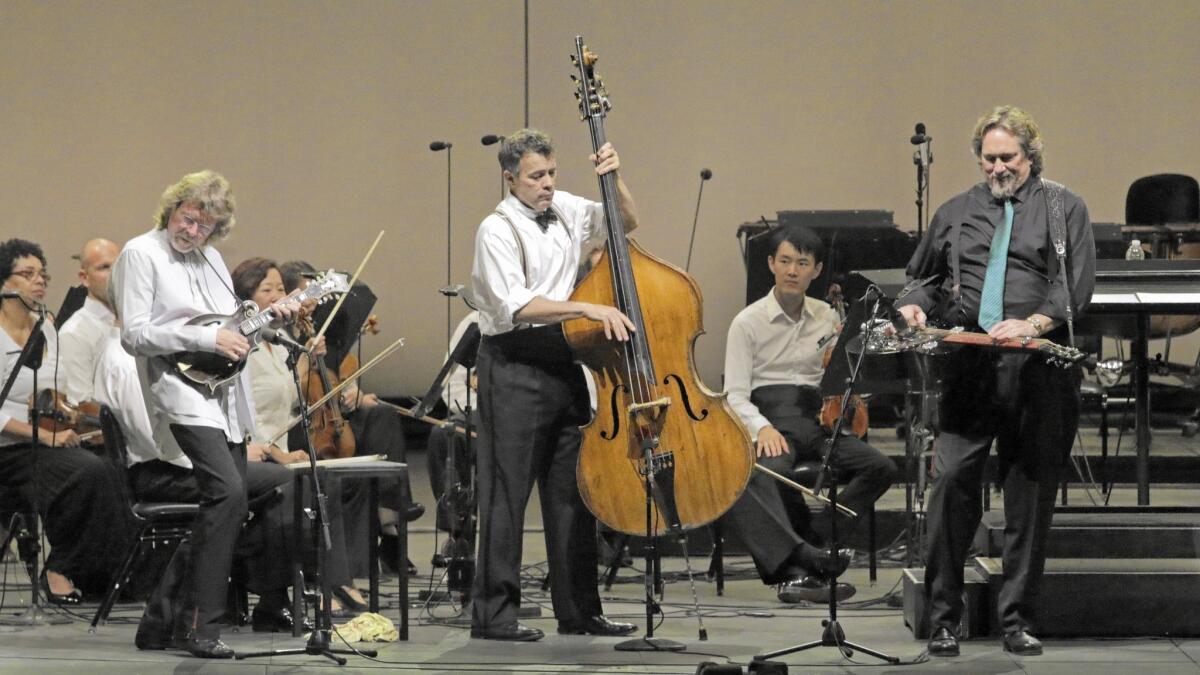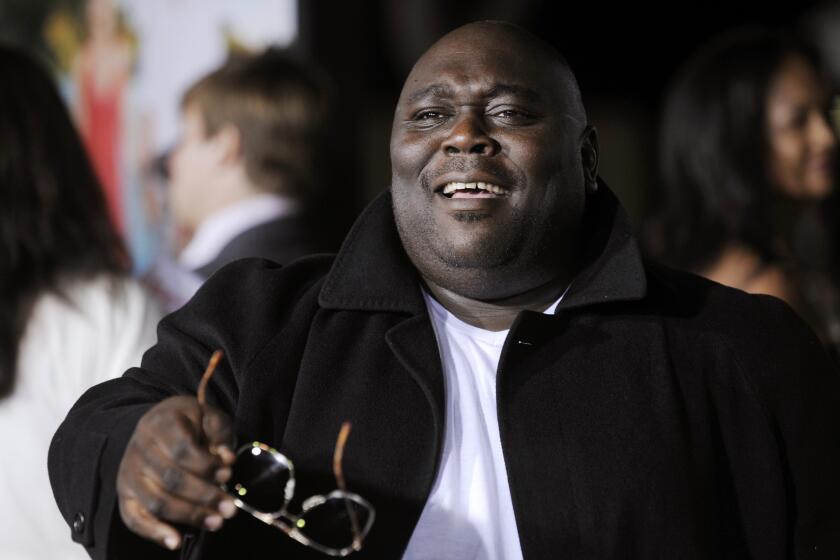Review: The Philharmonic dances through Bach and bluegrass at the Bowl

- Share via
Bluegrass has its roots in Appalachian music. Appalachian ballads have their roots in European dance music. No composer elevated dance music to higher spiritual grounds than Bach did. For all the off-putting genrefication of music these days, this has never been an art form suitable for a silo mentality. Music’s model is more the brain, with networks of neurons becoming ever more connected.
Hence the congenial night at the Hollywood Bowl Thursday entitled “From Bach to Bluegrass.” A British Baroque music specialist, Nicholas McGegan, conducted Bach’s Orchestral Suite No. 1. The popular, cross-genre bassist Edgar Meyer supplied the bluegrass. The evening ended with Copland’s “Appalachian Spring.” All, as McGegan reminded us, are dance music.
The outlier was the Bass Concerto No. 2 in B minor by Giovanni Bottesini, a 19th century Italian composer who is remembered, when remembered at all, as the Paganini of the bass. But once Meyer got through this slight piece, to which he added his own bluesy and bouncy cadences, it might as well have been dance music, close enough to bluegrass for comfort.
------------
FOR THE RECORD:
“Bach to Bluegrass” review: In the Aug. 29 Calendar section, a review of the “From Bach to Bluegrass” program at the Hollywood Bowl said that Los Angeles Philharmonic clarinetist Michele Zukovsky will be retiring at the end of the summer. She will retire in December. —
------------
SIGN UP for the free Essential Arts & Culture newsletter >>
For the most part this was a program fit for whiling away an evening during a late August heat wave. The temperature never dropped below 80 degrees, so the men in the orchestra performed in shirtsleeves and tieless, adding a not unwelcome casual atmosphere. The orchestra was small, chamber sized; the crowd, large (officially 8,406). At no moment did McGegan express anything other than good cheer.
Ironically, Gustavo Dudamel made more of an effort to bring an early music flavor to Bach’s Third Orchestral Suite last season at Walt Disney Concert Hall than McGegan did with the First in the Bowl. But given the severely limited rehearsal time for Bowl concerts, McGegan had little choice but to rely on efficiency. He did manage lively tempos and responsive phrasing from the players.
Meyer, who, though jacketless, kept on his bow tie and tuxedo cummerbund, gave swagger to Bottesini’s brief, tuneful concerto. He positioned his big bass into the microphone so as to use the vast amphitheater as a resonating chamber and produce earth-moving low notes. The robustness was as artificial as a heavily amplified electric bass. But in what some call the current meteorological conditions earthquake weather, such sonic tomfoolery imparted a diverting immediacy to an otherwise archaic concerto.
For three bluegrass numbers — “Emphysema Two Step,” “Green Slime” and “Unfolding” — after intermission, Meyer was joined by Sam Bush on mandolin and Jerry Douglas on dobro, both stars in their own bluegrass right. It might be intriguing to have an ambitious new bluegrass as the American equivalent to Astor Piazzolla’s new tango in Argentina. Meyer’s bluegrass remains more improvisational and less classical but nevertheless tweaks tradition in interestingly contemporary ways, making it maybe more the equivalent of a refined single-barrel bourbon.
In “Unfolding,” for which Meyer added a string orchestra accompaniment and which McGegan conducted with dancing Baroque gusto, Meyer’s playing inhabited two worlds comfortably. Here he applied classical techniques as a kind of spice to his bluegrass. Bush and Douglas, though underused, impressed with spectacular, time-honored cooking.
“Appalachian Spring,” which followed, has nothing to do with Appalachia. Copland wrote the score for Martha Graham before she had put the title on her 1943 dance. But it has come to symbolize American music, and this was the third time it has been programmed locally this summer. The complete ballet, in its original form for 13 instruments, was stiffly played at the Ojai Festival. At the Santa Barbara Bowl, the New York Philharmonic gave a bland performance of the orchestra suite Copland made from the ballet.
The L.A. Phil performance was again the chamber version for 13 instruments, but of the suite, and this time it was splendidly played. McGegan tried nothing fancy, relying on his excellent sense of rhythm and sane pacing. But his main accomplishment was in providing just enough security for individual players to bring out the real personality of the score.
That meant, in particular, the last time we will hear veteran clarinetist Michele Zukovsky, who will be retiring in December, set the tone with a haunting, lonely opening. This is the exact sound I remember hearing Copland once try to get from a clarinetist during a rehearsal. Zukovsky again led off the variations on the Shaker hymn “Simple Gifts” with spirited spirituality. The other dozen players, mostly orchestra principals, responded in kind.
Copland knew his Bach. He knew his bluegrass. And although he probably wouldn’t have cared a whit for the likes of Bottesini, he embodied, as this performance did, an Appalachia that is both American and part of the ever-expanding wide world of music.
MORE:
Conductor Mirga Grazinyte-Tyla brings her magic back to the Bowl
Substitutes shine in ‘Traviata’ at the Hollywood Bowl
Pianist Yundi adds some flair, but his Beethoven still lacks drama at Bowl
More to Read
The biggest entertainment stories
Get our big stories about Hollywood, film, television, music, arts, culture and more right in your inbox as soon as they publish.
You may occasionally receive promotional content from the Los Angeles Times.











